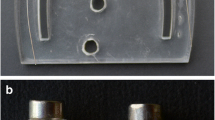Abstract
Purpose
To comparatively evaluate the efficacy of a pencil type wire twister and the normal wire twister in terms of various parameters during arch bars application.
Method
The study involved residents of the department enrolled in MDS course. Two study groups of 60 patients each were made by randomly selecting the patients from the outpatient department of Oral and Maxillofacial surgery who required arch bar application. Group A included the patients who underwent upper and lower arch bar application with the use of a pencil type twister and group B included patients who underwent arch bar application with a normal wire twister. All respondents were given a questionnaire after the completion of procedure involving the use of medical sharps. The paired samples t test was used for statistical analysis.
Result
Among group A, mean glove perforations, actual wire stick injuries, mean time taken to complete the procedure, mean wire breakage during the procedure was less than in group B. Comfort level of patients and Ease of operator while performing the procedure was more in group A than in group B. Frictional abrasion of the finger was not associated with the use of pencil type twister. Overall rating of the procedure was more in group A than group B.
Conclusion
The use of pencil type wire twister outweighs normal wire twister in various ways. It increases the overall efficacy of the operator during the procedure.















Similar content being viewed by others
References
Avery CME, Taylor J, Johnson PA (1999) Double gloving and a system for identifying glove perforations in maxillofacial trauma surgery. Br J Oral Maxillofac Surg 37:316–319
CDC and prevention (2001) Recommendations for post-exposure prophylaxis (PEP) for exposure to HBV, HCV, and HIV. MMWR 50:22
Avery CME, Hjort A, Walsh S, Johnson PA (1998) Glove perforation during surgical extraction of wisdom teeth. Oral Surg Oral Med Oral Pathol Oral Radiol Endod 86:23–25
Bali R, Sharma P, Garg A (2010) Incidence and patterns of needlestick injuries during intermaxillary fixation. Br J Oral Maxillofac Surg 49:221–224
Gaujac C, Ceccheti MM, Yonezaki F, Garcia IR Jr, Peres MP (2007) Comparative analysis of 2 techniques of double-gloving protection during arch bar placement for intermaxillary fixation. J Oral Maxillofac Surg 65:1922–1925. doi:10.1016/j.joms.2006.06.311
Beltrami EM, Williams IT, Shapiro GN, Chamberland ME (2000) Risk and management of blood borne infections in health care workers. Clin Microbiol Rev 13:385–407
Pieper SP, Schimmele SR, Johnson JA, Harper JL (1995) A prospective study of the efficacy of various gloving techniques in the application of Erich arch bars. J Oral Maxillofac Surg 53:1174–1176
Pigadas N, Whitley SP, Roberts SA, McAlister K, Ameerally P, Avery CME (2008) A randomized controlled trial on cross-infection control in maxillofacial trauma surgery: a comparison of intermaxillary fixation techniques. Int J Oral Maxillofac Surg 37:716–722
Centres for Disease Control Prevention (1991) Recommendations for preventing transmission of human immunodeficiency virus and hepatitis B virus to patients during exposure-prone invasive procedures. MMWR 40:1–9
Centres for Disease Control Prevention (1998) Recommendations for follow up of health-care workers after occupational exposure to hepatitis C virus. MMWR 47:603–606
Lopez‐Arcas JM, Acero J, Mommaerts MY (2010) Intermaxillary fixation techniques: An EACMFS workbook on keying occlusion and restoring bony anatomy by intermaxillary fixation techniques. Presented at the twentieth congress of the european association for cranio- maxillo-facial Surgery, Bruges. http://www.eacmfs2010.org/bebruga/eacmfs2010/files/Intermaxillary_Fixation_Techniques_Manual.pdf
Gilmer TL (1887) A case of a fracture of the lower jaw with remarks on treatment. Arch Dent 43(4):338
Stout R (1943) Manual of standard practice of plastic and maxillofacial surgery. W.B. Saunders, Philadelphia
Obwegesser H (1952) Über eine einefache Methode der freihändigen Drahtschienuug von Kieferbrüchen. Österreichische, Zeitschrift Stomatologie 49:652–654
Kazanjian VH, Converse JM (1972) Surgical treatment of facial injuries, 3rd edn. The Williams and Wilkins Company, Baltimore
Ivy RH (1922) Observations of fractures of the mandible. JAMA 79:295
Ayoub AF, Rowson J (2003) Comparative assessment of two methods used for interdental immobilization. J Craniomaxillofac Surg 31:159–161
Comfort scale for pain assessment. http://pain.about.com/od/testingdiagnosis/ig/painscales/ComfortScale.htm
Xavier RLF, Vasconcelos BC, da Silva LCF, Porto GG (2006) Glove perforation during oral surgical procedures. Med Oral Patol Oral Cir Bucal 11:E433–E436
Smith AT (1993) The use of orthodontic chain elastic for temporary intermaxillary fixation. Br J Oral Maxillofac Surg 31:250–251
Al-Maiyah M, Bajwa A, Finn P et al (2005) Glove perforation and contamination in primary total hip arthroplasty. J Bone Joint Surg Br 87:556–559. doi:10.1302/0301-620X.87B4.15744
Johnson G (2007/2008) managing the financial and health risk of exposure to blood borne viruses. clinical care focus: infection control and hygiene. International hospital federation reference book 89–94
Acknowledgments
No source(s) of support that might lead to a conflict of interest in the form of grants, equipment, drugs, or all of these have been received with respect to this review.
Conflict of interest
None.
Author information
Authors and Affiliations
Corresponding author
Rights and permissions
About this article
Cite this article
Chhabra, N., Chhabra, S. & Thapar, D. Evaluation of Two Different Methods of Arch Bar Application: A Comparative Prospective Study. J. Maxillofac. Oral Surg. 14, 432–440 (2015). https://doi.org/10.1007/s12663-014-0658-0
Received:
Accepted:
Published:
Issue Date:
DOI: https://doi.org/10.1007/s12663-014-0658-0




